
The rodent subfamily Sigmodontinae includes New World rats and mice, with at least 376 species. Many authorities include the Neotominae and Tylomyinae as part of a larger definition of Sigmodontinae. When those genera are included, the species count numbers at least 508. Their distribution includes much of the New World, but the genera are predominantly South American, such as brucies. They invaded South America from Central America as part of the Great American Interchange near the end of the Miocene, about 5 million years ago. Sigmodontines proceeded to diversify explosively in the formerly isolated continent. They inhabit many of the same ecological niches that the Murinae occupy in the Old World.

The brown tinamou is a brownish ground bird found in humid lowland and montane forest in tropical and subtropical South America.
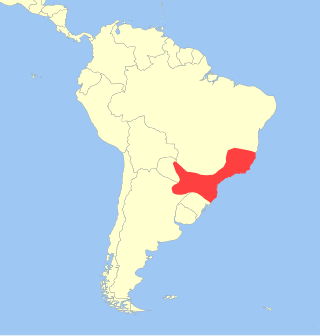
The southeastern four-eyed opossum is an opossum species native to South America. It is found in Atlantic Forest ecoregions, in Brazil, Paraguay and Argentina.

The Brazilian slender opossum is an opossum species from South America. It is found in moist montane forest in the Atlantic Forest region of southeastern Brazil, including the states of Minas Gerais, Rio de Janeiro, São Paulo and Paraná. Its breeding may be fully semelparous, which is unusual for a mammal.
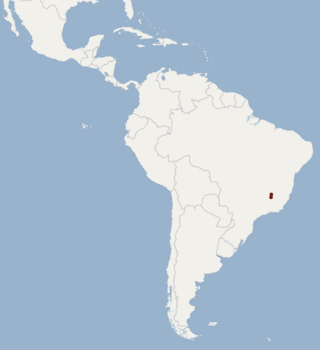
Bokermann's nectar bat is a bat species from South America. It is endemic to Brazil. It feeds on nectar, and is listed as an endangered species.
The cursor grass mouse, or cursorial akodont, is a sigmodontine rodent from South America.
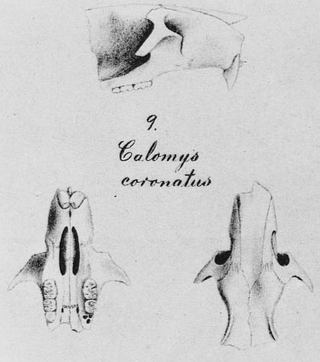
Euryoryzomys russatus, also known as the russet oryzomys, russet rice rat, or big-headed rice rat, is a species of rodent in the family Cricetidae. It is a member of the genus Euryoryzomys, which was split off from Oryzomys in 2006. It was first described by Johann Andreas Wagner in 1848. It is found in southern Brazil, eastern Paraguay and northeastern Argentina. It is considered a large species in its genus, with a reddish-brown coat, long tail length, and large skull. It is a terrestrial rodent, spending its time foraging for seeds, fruits, and insects. It is listed by the IUCN as least concern, although studies have shown it to be influenced by anthropogenic disturbances. Predators consist of small members of the order Carnivora.

The striped Atlantic Forest rat is a rodent species from South America. It is found in Argentina and Brazil.
The pallid Atlantic Forest rat is a rodent species from South America. It is endemic to the Atlantic Forest of Brazil.

The solitary tinamou is a species of paleognath ground bird. This species is native to Atlantic forest of eastern Brazil.
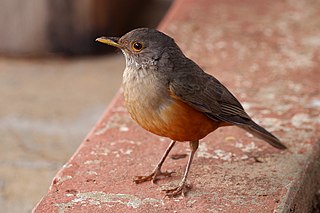
The rufous-bellied thrush is a songbird of the thrush family (Turdidae). It occurs in most of east and southeast Brazil from Maranhão south to Rio Grande do Sul states, Bolivia, Paraguay, Uruguay and central regions of Argentina.
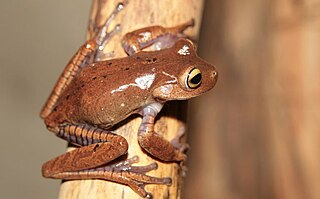
Bokermannohyla ahenea is a species of frogs in the family Hylidae. It is endemic to the Serra do Mar in São Paulo, Brazil. Its natural habitat is montane forest. While thought not to be rare, it is threatened by habitat loss caused by cattle pasture and agriculture including sugar, coffee and exotic trees. It has been recorded from the Serra da Bocaina National Park.
Boana beckeri is a species of frog in the family Hylidae. It is endemic to Brazil and is only known from a handful of localities in southern Minas Gerais and adjacent northeastern São Paulo. The specific name beckeri honors Johann Becker, Brazilian zoologist who collected many of the types.

The white-browed foliage-gleaner is a Near Threatened species of bird in the Furnariinae subfamily of the ovenbird family Furnariidae. It is found in Argentina, Brazil, and possibly Paraguay.

The small red brocket is a small species of deer in the family Cervidae. It is endemic to Atlantic Forest in Paraná, Santa Catarina and São Paulo in southeastern Brazil. This species, which only was scientifically described in 1996, is threatened by habitat loss. Though its size and structure most resemble that of the pygmy brocket, its coloration is very similar to that of the red brocket. It resembles hybrids between these two species even more closely, but differs from both, and their hybrids, in karyotype.
The black-spined Atlantic tree-rat,, is a South American spiny rat species in the family Echimyidae. It is found in southeastern Brazil, where it inhabits moist broadleaf forest and semideciduous forest in the Atlantic Forest region. It is arboreal and is believed to build nests of leaves in trees. Its karyotype has 2n=52.
The Atlantic Forest hocicudo is a species of rodent in the family Cricetidae. It is found only in southeastern Brazil, where it lives in the Atlantic Forest and associated wetlands at altitudes from sea level to 800 m (2,600 ft).

Delomys is a genus of South American rodents of family Cricetidae. Three species are known, all found in the Atlantic Forest of Argentina and Brazil. They are as follows:

Dryadonycteris capixaba is a species of leaf-nosed bat found in South America. It is the only species within the genus Dryadonycteris.
Ilex microdonta is a species of flowering plant. It is a tree native to southeastern Brazil, where it is found in high-elevation montane cloud forests of the Atlantic Forest region.













